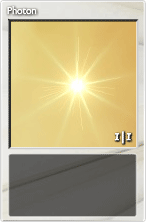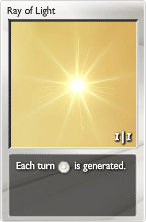Photon
|
|
Contents
Overview
Photon is one of the simplest creatures in Elements. As a light creature, it has only one attack and one HP, making it a very frail and weak attacker. However, because of its free cost, Photon (and subsequently Ray of Light) are both extremely useful in setting up several strategies ranging from quanta gain, specialized damage mitigation, and more.
General Use
Quick Facts:
- Both Photon and its upgraded form, Ray of Light, have a 0 cost (free to play whenever, like pillars and pendulums)
- Ray of Light (the upgrade) can generate 1
 quanta each time it attacks
quanta each time it attacks - A.I. opponents will generally play cards that have no cost as quickly as possible, including Photons
Photon and its upgraded form, Ray of Light (or ‘RoL’), are one of the few cards in game that don’t require any quanta to play. In other words, you can place them on the field whenever you want. The very fact that it’s free gives many players several quanta advantages - even more so for its upgraded form.
While Photon is a basic creature, Ray of Light is a special creature that generates 1 ![]() quanta each turn it’s active (non-stunned). Its bioluminescence ability (only shared with Fireflies, named ‘Light’ as its active skill) can therefore assist the player in obtaining the
quanta each turn it’s active (non-stunned). Its bioluminescence ability (only shared with Fireflies, named ‘Light’ as its active skill) can therefore assist the player in obtaining the ![]() quanta needed to play various Light cards, assuming that the Ray of Light isn’t killed during the process.
quanta needed to play various Light cards, assuming that the Ray of Light isn’t killed during the process.
Synergies
 Ironically, Ray of Light can also serve as another form of quanta generation by being killed through Immolation | Cremation. Instead of a steady source of
Ironically, Ray of Light can also serve as another form of quanta generation by being killed through Immolation | Cremation. Instead of a steady source of ![]() , one can instantly generate a significant amount of
, one can instantly generate a significant amount of ![]() quanta to play Fire cards instead. Since both Immolation (or Cremation) and Photon (or RoL) are both free, having them both in one’s starting hand can effectively allow someone to ignore threats of Earthquake against pillars or pendulums.
quanta to play Fire cards instead. Since both Immolation (or Cremation) and Photon (or RoL) are both free, having them both in one’s starting hand can effectively allow someone to ignore threats of Earthquake against pillars or pendulums.
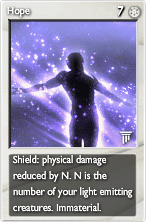 Another major asset of the Ray of Light is its immense synergy with Hope | Hope - the Hope shield is another Light card that reduces damage taken based on how many creatures have the ‘Light’ (Bioluminescence) ability on the field. Rays of Light directly assist with the damage reduction total with their ability - combined with Fractal, one could fill up the field with several Ray of Light creatures (since they’re free to play) to not only produce the necessary
Another major asset of the Ray of Light is its immense synergy with Hope | Hope - the Hope shield is another Light card that reduces damage taken based on how many creatures have the ‘Light’ (Bioluminescence) ability on the field. Rays of Light directly assist with the damage reduction total with their ability - combined with Fractal, one could fill up the field with several Ray of Light creatures (since they’re free to play) to not only produce the necessary ![]() quanta to utilize other Light cards, but also to reduce the amount of damage opposing creatures can deal. However, this strategy isn’t as effective against heavy CC opponents with cards such as Plague, Fire Shield, or Lobotomizer, which will kill the Ray of Light creatures or nullify their effect. Nonetheless, the ‘RoL-Hope’ deck is very popular against False Gods, as it uses this strategy effectively against False Gods with poor creature control.
quanta to utilize other Light cards, but also to reduce the amount of damage opposing creatures can deal. However, this strategy isn’t as effective against heavy CC opponents with cards such as Plague, Fire Shield, or Lobotomizer, which will kill the Ray of Light creatures or nullify their effect. Nonetheless, the ‘RoL-Hope’ deck is very popular against False Gods, as it uses this strategy effectively against False Gods with poor creature control.
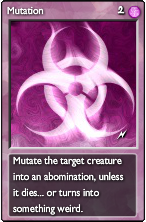 The final (and most unusual) use is the combination of Photons with Mutation | Improved Mutation. Although it is extremely luck based, one could literally obtain a very dangerous creature with high stats and a frustrating ability (like Steal or Devour) with the two-card combo that barely uses any quanta (2-3
The final (and most unusual) use is the combination of Photons with Mutation | Improved Mutation. Although it is extremely luck based, one could literally obtain a very dangerous creature with high stats and a frustrating ability (like Steal or Devour) with the two-card combo that barely uses any quanta (2-3 ![]() total). The low quanta cost can be very impressive in generating special mutants against your opponents, but can also be countered by denial (Rewind and loss of quanta from the mutant’s elemental type) or deflated by poor luck (mutating a photon into a 2|2 Photon with Immaterial).
total). The low quanta cost can be very impressive in generating special mutants against your opponents, but can also be countered by denial (Rewind and loss of quanta from the mutant’s elemental type) or deflated by poor luck (mutating a photon into a 2|2 Photon with Immaterial).
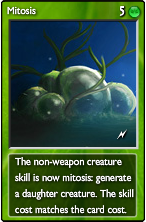 The Photon is free, if you use Mitosis you can generate a Photon every turn, and if you use also fallen elf|fallen druid you can generate a mutant every turn!
The Photon is free, if you use Mitosis you can generate a Photon every turn, and if you use also fallen elf|fallen druid you can generate a mutant every turn!
Other Cards With Synergy
Both Photon and its upgraded form can be used in other ways as well - because of its accessibility, one could theoretically buff it with several spells (Blessing, Chaos Power, or even Momentum) to make it a decent attacker on the field with the right elements. In other decks, some use it as a way to prevent deck-out with Eternity (using the ability Rewind on it after playing the card onto the field), making it perfect as an anti-deck out strategies. One could even use Nightmare on this card against some of the A.I. while utilizing the Dune Scorpion’s ‘Neurotoxin’ ability; as the A.I. will (generally) play any creature out in their hand onto the field with enough quanta, they’ll play all of their Photons immediately after obtaining a handful of them from Nightmare, increasing the poison counter from the Neurotoxin effect. Butterfly Effect and Aflatoxin can also be used on the creature to provide reusable permanent destruction or a field of Malignant Cells to swarm the opponent. Overall, these functions of Photon are fairly distinct from one another, and may be unorthodox to use.
Furthermore, Rustlers can also convert the excess ![]() quanta into
quanta into ![]() (via Photosynthesis) at a 1:2 ratio; since Photosynthesis can be used multiple times, packing several Rays of Light alongside a Rustler could possibly generate more
(via Photosynthesis) at a 1:2 ratio; since Photosynthesis can be used multiple times, packing several Rays of Light alongside a Rustler could possibly generate more ![]() than having Life pillars alone. Adrenaline on a Ray of Light can also help. In addition to attacking the opponent multiple times, the Ray of Light will also generate 1
than having Life pillars alone. Adrenaline on a Ray of Light can also help. In addition to attacking the opponent multiple times, the Ray of Light will also generate 1 ![]() quanta each time it attacks, increasing its damage and quanta generation. In many cases, Ray of Light can be vital for gaining quanta as efficiently as possible, depending on what type of elemental quanta you need.
quanta each time it attacks, increasing its damage and quanta generation. In many cases, Ray of Light can be vital for gaining quanta as efficiently as possible, depending on what type of elemental quanta you need.
Conclusion
All in all, Photon and Ray of Light may appear to be useless creatures for the endgame with 1|1 stats, but are incredibly beneficial for various decks and suited for numerous purposes. Players should always be suspicious of an opposing Photon or Ray of Light, as their role in the deck can vary dramatically.
Popular Deck
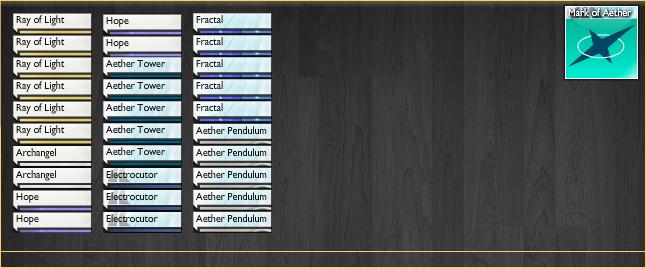
7jp 7jp 7jp 7jp 7jp 7jp 7ju 7ju 7k4 7k4 7k4 7k4 808 808 808 808 808 80e 80e 80e 80i 80i 80i 80i 80i 81q 81q 81q 81q 81q 8pu
